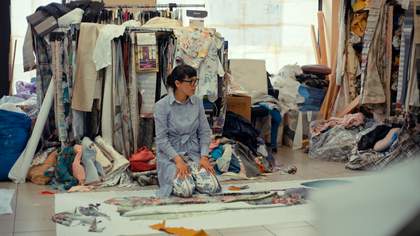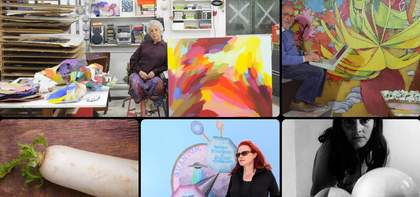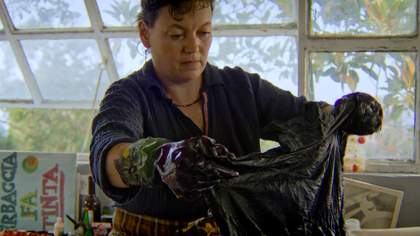Throughout art history, the greatest advancements were during times of revolution. We had the renewal in art through Christian painting, feudalists to capitalists brought the Renaissance painting and the beginning of working-class revolution with the Soviet revolution brought abstraction.
I was saying, ŌĆ£Why am I painting in oil? What is the technology of my time?ŌĆØ
IŌĆÖve been working on this huge painting. I put it on Instagram. I asked people, ŌĆ£What is the place and space you see? Do you want to swim or dance?ŌĆØ Madison says, ŌĆ£Snowball fights but with flowers!ŌĆØ, ŌĆ£Fireworks and honks!ŌĆØ. Oh, thatŌĆÖs cute, I want them to say what theyŌĆÖre feeling. ŌĆ£Feels like walking through a tropical flower garden.ŌĆØ So I like these reactions.
Generally, people donŌĆÖt have trouble with abstraction. ItŌĆÖs educated people who have trouble with abstraction. LetŌĆÖs see, so far, it has garnered 561 viewers and 51 comments. So painting is easier to take than my political statements. Anyway, itŌĆÖs not complete, folks, we will keep you posted.
My inspiration is 100% nature and reality. These are pieces of tiles I collected in Jaffa, Palestine, which were falling out of grave sites up the beach into the ocean, and then being smoothed by the ocean. So I picked them as mementos of where I spent my childhood.
I was born in Jerusalem, and when I was a toddler my father decided to move his family to ┘Ŗž¦┘üž¦ Jaffa in English. At age 11, the British had brought the Zionist movement to Palestine, and we escaped via air to Beirut from the fighting, and were unable to go back, ever. And so, I have this incredible romance with Palestine.
In 1951, my father decided he was worried about the situation, and he wrapped up his family and came to the US. He bought a Buick in New York, and he stuffed us in the car, and off we went.
I could have been a mathematician, I was thinking about it. And my mother says, ŌĆ£Well, you always enjoyed drawing. Why donŌĆÖt you study art?ŌĆØ My father was always supportive also. But of course, my father paid more attention to his two sons than he did to his daughter. So I didnŌĆÖt get any pressure. Actually, being female gave me more freedom.
Tribeca, when I arrived, was a very abandoned-looking place, with no streetlights. It was dark to walk the streets at night. A friend of mine had come to spend the night with me, and her father saw a light and he said, ŌĆ£If you have problems, you can run down there.ŌĆØ And I thought, run two blocks to the babydoll topless bar? That wasnŌĆÖt what would have saved us.
If you notice, there is a rhythm here, to the walking. You can almost see it in the up-and-down jumping of heights and people. I keep looking at the world from a roving point of view. Everybody has a huge bank of memory, and thatŌĆÖs why people can enjoy the abstractions, they will immediately recognise something. So to me, this is the best confirmation of what IŌĆÖm doing, that you recognise something.
ŌĆ£You have a very dirty window.ŌĆØ Just consider it decorative, smoky colour. This has a great influence on my work. The window is very important in human civilisation. As human beings, we live with rectangles. In fact, we are so limited by our notion of space that the right angle and rectangles are all we do, all the time. I pushed myself into three-dimensionality, free of the stretcher, completely free of the window. I returned abstraction to the rectangle because I could now live with myself, that this is not illusion. This is not a world through a camera; this is a recipient of ideas.
Look at how the shopkeepers arrange everything of a kind, but also thereŌĆÖs a certain artistry to how they fix things. You know, this becomes like the column becomes a work of art in itself.
Travelling has a big effect on my perception and my work. IŌĆÖve been through many parts of the Arab world and Europe. When IŌĆÖm in other locations, I always feel a freedom.
In the sixties, I was thinking strictly of how we see. There were deep influences from the Renaissance, the idea of shading, illuminating objects. What was interesting to me is, intuitively and instinctively, I was using the formal compositional methods of Arabic medieval art, in that the container of the art as a rectangle participated very actively with the artwork itself. In this case, the rectangle casts shadows on the objects in the painting, which is not what Western painting does.
I had taken a very strong step into abstraction by just questioning. The difference for me between abstraction and perspective is that IŌĆÖm using the principles of nature, rather than the appearance of nature from one instant in time.
Look at all the pigeons gathering. These are other principles one can watch how things gather, how they congregate. There they go, beautiful.
When I came to New York, I tried to find a gallery because, after all, you do want to sell a little bit. But I couldnŌĆÖt. I remember days of waiting. Someone would say theyŌĆÖre coming, and they would never show up. It was endless. Finally, I gave up.
As a result, I decided IŌĆÖm going to try to relate to the political resistance world. I felt a lot of freedom and liberation during the eighties, because I was no longer paying attention to the galleries, I was paying attention to the activism.
It was here that I first started thinking of doing digital art. I gave up education, I gave up having jobs, and I gave up the New York art scene. ItŌĆÖs time to do the computer. So I went shopping and I found an Amiga. I was in a fever of experimentation.
I had a partner who lived with me at the time, and he cooked dinner, so I didnŌĆÖt leave that computer for months, maybe a year.
Okay, IŌĆÖm going to turn the computer on now. See? I used to sit with a friend and weŌĆÖd often giggle also. ItŌĆÖs a delight and a surprise to see this coming out of a computer, the last thing we expected to see in 1987, 88.
The art world had a very negative attitude to computers. I did it because I was hypnotised by it, not because I was going to please the galleries. They were interested in the commercial potential, and I was interested in abstraction.
This is the setup that I will be using to perform. Each key is able to do quite a lot of stuff, depending on what else I press. These are my crib sheets, or my practice sheets and when I perform, I get a little nervous sometimes, so I have to really memorise and study this. And I canŌĆÖt always predict whatŌĆÖs going to be.
The painting is all you. Any mistakes and stupidities you apply to it is you. Here, thereŌĆÖs chance also, combinations that I didnŌĆÖt expect.
Brass Women starts with this very slow-moving set of shapes that look feminine, inspired by the women in Palestine. ItŌĆÖs a dedication to African American and women of Latin origins, with whom I worked during the eighties and nineties.
Whatever the rhythm is doing, I just canŌĆÖt resist, I start jamming pictures with musicians. The kind of painting I want to do is painting that reflects our time, that has the newest language to include the newest content of our time.
I see the history of art as being connected to our human social development. And so, IŌĆÖve based my work on that idea. I consider it to be a painting but more a painting of our time than acrylic on canvas.
Step inside the studio of Palestinian-American artist Samia Halaby, one of the earliest innovators of digital art. In the mid-1980s, Halaby bought an Amiga computer and taught herself how to code. With it she produced bold, colourful 'kinetic paintings', consisting of vivid, brightly coloured geometric shapes and slanting lines shifting restlessly in all directions.
For Halaby, these works were a continuation of the abstract paintings she had been creating in oils and acrylic since the 1960s. In this film, we travel with Halaby from her New York studio to London for a special musical performance at ║┌┴Ž╔ń, as well as the opening of a new commission at Outernet London, where her works are shown on a scale like never before.
Research supported by Hyundai Tate Research Centre: Transnational in partnership with Hyundai Motor



